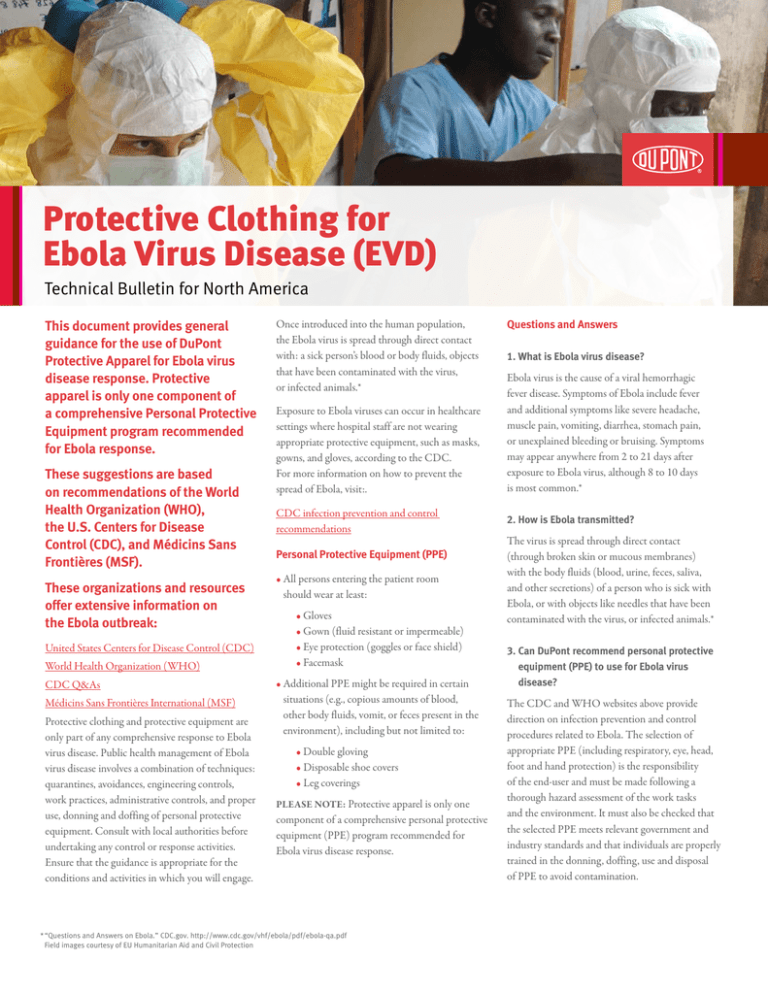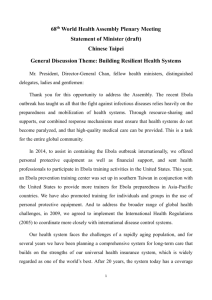
Protective Clothing for
Ebola Virus Disease (EVD)
Technical Bulletin for North America
This document provides general
guidance for the use of DuPont
Protective Apparel for Ebola virus
disease response. Protective
apparel is only one component of
a comprehensive Personal Protective
Equipment program recommended
for Ebola response.
These suggestions are based
on recommendations of the World
Health Organization (WHO),
the U.S. Centers for Disease
Control (CDC), and Médicins Sans
Frontières (MSF).
These organizations and resources
offer extensive information on
the Ebola outbreak:
United States Centers for Disease Control (CDC)
World Health Organization (WHO)
CDC Q&As
Médicins Sans Frontières International (MSF)
Protective clothing and protective equipment are
only part of any comprehensive response to Ebola
virus disease. Public health management of Ebola
virus disease involves a combination of techniques:
quarantines, avoidances, engineering controls,
work practices, administrative controls, and proper
use, donning and doffing of personal protective
equipment. Consult with local authorities before
undertaking any control or response activities.
Ensure that the guidance is appropriate for the
conditions and activities in which you will engage.
Once introduced into the human population,
the Ebola virus is spread through direct contact
with: a sick person’s blood or body fluids, objects
that have been contaminated with the virus,
or infected animals.*
Exposure to Ebola viruses can occur in healthcare
settings where hospital staff are not wearing
appropriate protective equipment, such as masks,
gowns, and gloves, according to the CDC.
For more information on how to prevent the
spread of Ebola, visit:.
CDC infection prevention and control
recommendations
Personal Protective Equipment (PPE)
• All persons entering the patient room
should wear at least:
• Gloves
• Gown (fluid resistant or impermeable)
• Eye protection (goggles or face shield)
• Facemask
• Additional PPE might be required in certain
situations (e.g., copious amounts of blood,
other body fluids, vomit, or feces present in the
environment), including but not limited to:
• Double gloving
• Disposable shoe covers
• Leg coverings
PLEASE NOTE: Protective apparel is only one
component of a comprehensive personal protective
equipment (PPE) program recommended for
Ebola virus disease response.
* “Questions and Answers on Ebola.” CDC.gov. http://www.cdc.gov/vhf/ebola/pdf/ebola-qa.pdf
Field images courtesy of EU Humanitarian Aid and Civil Protection
Questions and Answers
1. What is Ebola virus disease? Ebola virus is the cause of a viral hemorrhagic
fever disease. Symptoms of Ebola include fever
and additional symptoms like severe headache,
muscle pain, vomiting, diarrhea, stomach pain,
or unexplained bleeding or bruising. Symptoms
may appear anywhere from 2 to 21 days after
exposure to Ebola virus, although 8 to 10 days
is most common.*
2. How is Ebola transmitted?
The virus is spread through direct contact
(through broken skin or mucous membranes)
with the body fluids (blood, urine, feces, saliva,
and other secretions) of a person who is sick with
Ebola, or with objects like needles that have been
contaminated with the virus, or infected animals.*
3. Can DuPont recommend personal protective
equipment (PPE) to use for Ebola virus
disease?
The CDC and WHO websites above provide
direction on infection prevention and control
procedures related to Ebola. The selection of
appropriate PPE (including respiratory, eye, head,
foot and hand protection) is the responsibility
of the end-user and must be made following a
thorough hazard assessment of the work tasks
and the environment. It must also be checked that
the selected PPE meets relevant government and
industry standards and that individuals are properly
trained in the donning, doffing, use and disposal
of PPE to avoid contamination.
The information provided by DuPont is not
intended as a substitute for any hazard assessment
testing that the end-user needs to conduct to
determine the suitability of our products for their
particular purposes. This information is offered for
consideration and is not a recommendation.
4. Which DuPont garments comply with
North American standards for blood-borne
pathogens (ASTM F1670 and ASTM F1671)?
DuPont™ Tychem® QC and DuPont™ Tychem® SL
fabrics and their taped seams have been tested
and passed the requirements of North America
ASTM Standards F1670 and ASTM F1671.
Product compliance to those two standards
can be found here:
ASTM F1670
ASTM F1671
Additionally, Tychem® QC or Tychem® SL
aprons can be worn on top of the coveralls.
PPE is recommended for people assisting with disinfection.
PLEASE NOTE: Fabrics and seams are tested using
5. What does it mean to be compliant to the
ASTM F1670 and ASTM F1671 tests?
recognized procedures to determine the level of
barrier against proxy materials for blood-borne
pathogens. They are not tested against specific
viruses, such as Ebola.
The garment fabric and seams have been tested by
an independent third party lab to ASTM Standard
test methods:
• ASTM F1670 – Standard Test Method for
Resistance of Materials Used in Protective
Clothing to Penetration by Synthetic Blood
Additional Information on DuPont Personal
Protection Products and Relevant Standards
• ASTM F1671 – Standard Test Method for
Resistance of Materials Used in Protective
Clothing to Penetration by Blood-Borne
Pathogens Using Phi-X174 Bacteriophage
Penetration as a Test System
Bloodborne Pathogens
Protective Clothing and
DuPont Tychem Garments
™
®
DuPont Tychem QC 125T
™
®
DuPont Tychem SL 120T
™
®
DuPont Tychem SL 121T
™
®
DuPont Tychem SL 125T
™
®
DuPont Tychem Accessories
™
®
1
DuPont Tychem QC 273B Apron
™
DuPont Tychem SL 274B Apron
®
™
®
DuPont Tychem SL 275T Apron
™
®
1. Accessories alone will not provide adequate protection.
DISCLAIMER:
This information is based upon technical data that DuPont believes to be reliable. It is subject to revision as additional knowledge and experience
are gained. DuPont makes no guarantee of results and assumes no obligation or liability in connection with this information. It is the user’s
responsibility to determine the nature and level of hazard and the proper personal protective equipment needed. The information set forth herein
reflects laboratory performance of fabrics, not complete garments, under controlled conditions. It is intended for informational use by persons
having technical skill for evaluation under their specific end-use conditions, at their own discretion and risk. Anyone intending to use this
information should first verify that the garment selected is suitable for the intended use. In many cases, seams and closures have lower barrier
performance than the fabric. Tychem and Tyvek garments are intended for limited use and can be worn until damaged, altered or contaminated.
These garments should not be laundered for reuse in protective apparel or cleanroom applications. Damaged, altered or contaminated garments
should be disposed of in an appropriate manner. SINCE CONDITIONS OF USE ARE OUTSIDE OUR CONTROL, WE MAKE NO WARRANTIES, EXPRESSED
OR IMPLIED, INCLUDING, WITHOUT LIMITATION, NO WARRANTIES OF MERCHANTABILITY OR FITNESS FOR A PARTICULAR USE, AND ASSUME NO
LIABILITY WHATSOEVER IN CONNECTION WITH ANY USE OF THIS INFORMATION. This information is not intended as a license to operate under, or a
recommendation to infringe upon, any trademark, patent or technical information of DuPont or others covering any material or its use.
®
®
WARNINGS:
1) Tyvek , ProShield Basic, ProShield , ProShield NexGen and most Tychem fabrics are not flame resistant and should not be used around heat,
flame, sparks or potentially flammable or explosive environments.
®
®
®
®
®
®
2) Tychem should not be used around heat, flames, sparks or in potentially flammable or explosive environments. Only Tychem ThermoPro,
Tychem Reflector and Tychem TK styles 600T/601T (with aluminized outer suit) garments are designed and tested to help reduce injury during
escape from a flash fire. Users of Tychem ThermoPro, Tychem Reflector and Tychem TK styles 600T/601T (with aluminized outer suit) garments
should not knowingly enter an explosive environment. Consult the Tychem user manual, located on our website, for instructions on proper use,
care and maintenance of your Tychem garments.
®
®
®
®
®
®
®
®
®
®
®
3) Garments should have slip-resistant or antislip materials on the outer surface of boots, shoe covers or other garment surfaces in conditions
whereslipping could occur.
4) If fabric becomes torn, scratched or punctured, or if a garment closure or seam fails, user should immediately discontinue use of garment to
avoid serious injury, including potentially deadly chemical exposure(s). Seams and closures may provide less protection than fabric.
Customer Service:
United States: 1 800 931 3456
Canada: 1 800 387 9326
www.PersonalProtection.DuPont.com
5) Serged and/or bound seams are degraded by some hazardous liquid chemicals, such as strong acids, and should not be worn when these
chemicals are present.
6) The outer glove on Tychem Reflector , Tychem TK600T and TK601T suits may contain natural rubber latex which may cause allergic reactions in
some sensitized individuals. Additionally, some internal components not expected to contact the wearer during use may contain natural rubber
latex which may cause allergic reactions in some sensitized individuals. Anyone who begins to exhibit an allergic response during the use of
DuPont products should immediately cease using these products. The incident should also be reported to DuPont at 1-800-441-3637 so that an
investigation can be initiated.
®
®
®
Copyright © 2014 DuPont. All rights reserved. The DuPont Oval Logo, DuPont , Tychem , Tyvek and all products denoted with ™ or ® are registered
trademarks or trademarks of E. I. du Pont de Nemours and Company or its affiliates. (11/14)
™
®
®
www.SafeSPEC.DuPont.com



